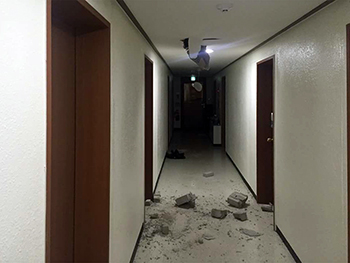
At 8:33 p.m. on Sept. 12, a 5.8-magnitude earthquake in Gyeongju jolted most of the country, and aftershocks of 4.5- and 3.1-magnitude followed on Sept. 19 and 21 near Gyeongju. The tremor was most strongly felt near the epicenter Gyeongju, a historic city in the southeastern province of North Gyeongsang. However, the shocks were felt equally strong in Pohang, 21km north of Gyeongju, and as far as Seoul, which is more than 276km away.
On the day of the first quake, Lee Jong-jun, a sophomore attending Pohang University of Science and Technology, was having dinner with his family at a nearby mall. Starting suddenly at 8:33 p.m. and lasting for about 30 seconds, the ground shook, and items on shelves fell off.
“It was my first experience with an earthquake, which was scary and cool at the same time,” Lee said. “When I went to school the next day, many students were still in a state of shock. Now when someone senses a small vibration of the floor, they become very sensitive towards it.”
Like Lee, many people in Korea had not really experienced an earthquake before, as this was the most powerful earthquake in Korea since 1978, when the country started measuring tremors. Furthermore, most Koreans have long considered the country a safe haven from earthquakes in comparison to Japan, which is prone to numerous quakes.
Unfortunately, this complacent view has lent itself to a lack of earthquake drill practices in the public educational system. Based on data from Incruit, a job recruitment Web site, 53.7 percent of the 927 participants selected the statement that they have “not received any safety education or evacuation drill regarding earthquakes since middle and high school.” Also, 78.3 percent admitted that “they do not have any evacuation plans for an earthquake.” The poll showed the reality of how students are vulnerable to such a natural disaster.
Luckily in Ewha, practice safety drills take place every May in two randomly picked buildings. Students are taught of evacuation routes in case of a natural disaster and a civil defense drill. The education is mandatory for all dormitory students.
“Safety is something we take care seriously,” said a general maintenance official at Ewha. “We believe that the earthquake is not limited to the eastern part of Korea. We therefore are making sure all the announcements and the safety precautions from the central government are in practice on campus.”
For future guidelines, when an earthquake hits, students who are at indoors must hide under a table or a desk to protect their head and body. Only when it stops shaking should students evacuate to an open area. When you are outside, students must avoid standing around buildings or any wall which may fall and listen carefully to the radio or any announcements.

